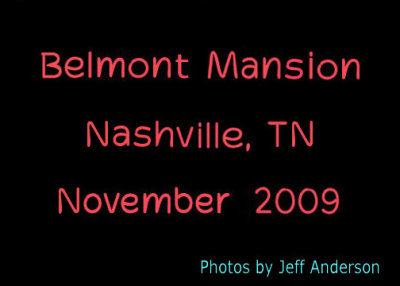
Belmont Mansion Nashville, TN cover page. |

Map of Tennessee with the star indicating Nashville. |
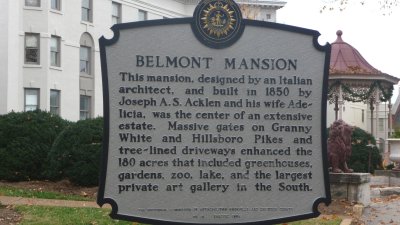
Sign outside of Belmont Mansion, which was built by Adelicia Acklen and her second husband Joseph. |
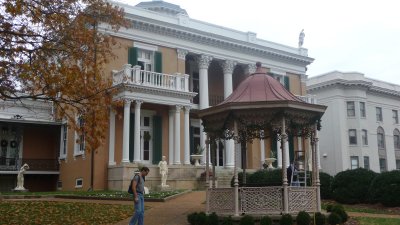
View of the Italianate façade and of a gazebo in front of Belmont. It was built as a summer home. |
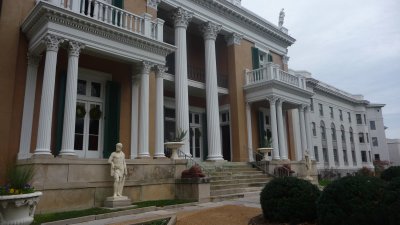
Statuary outside the antebellum mansion. Adelicia Acklen acquired many statues on her grand tour of Europe between 1865-1866. |
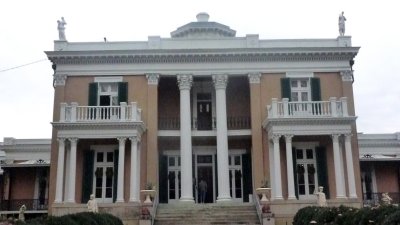
Frontal view of Belmont Mansion. Adelicia and her second husband Joseph Acklen had it built from 1849-1853. |

The Acklens built, furnished, and landscaped one of the most elaborate homes in the South, with 36 rooms and 19,000 acres. |
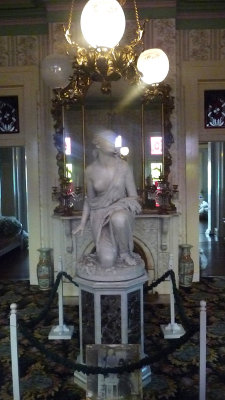
Sculpture by Randolph Rogers by in the Front Hallway. He also designed the Capital doors in Washington, D.C. |
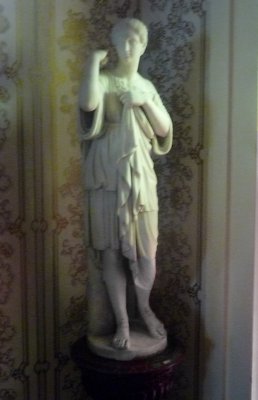
Another sculpture in the front hallway acquired by Adelicia in Europe is of the goddess, Adalanta. |
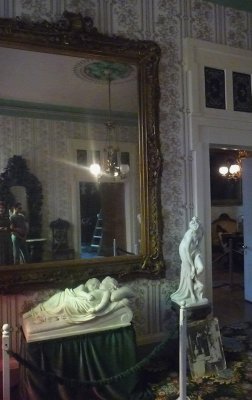
Sculpture entitled the "Sleeping Children," a memorial to Laura and Corinne, Adelicia's 2 daughters, who died of scarlett fever. |

Both Laura and Corinne died at age two. Only 4 of Adelicia's 10 children outlived her. |

Mirror and marble sculpture in the Front Hallway. Most of the mirrors in the house are original. |

Gaselier chandelier. The wallpaper and ceiling colors are reproductions of what Adelicia had when she built Belmont Mansion. |

All but one of the fireplace mantels on the first floor are original to the house. |
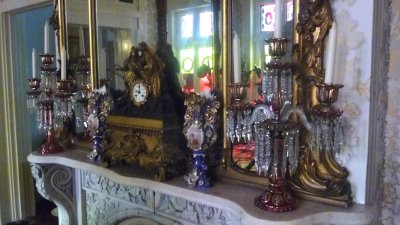
Beautiful clock and crystal candle holders on the mantelpiece. Stained glass of the front windows is reflecting in the mirror. |
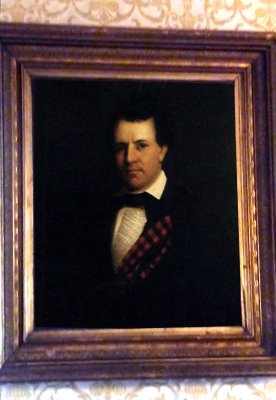
Portrait of Joseph Acklen, Adelicia's 2nd husband. He was a talented property manager who helped triple Adelicia's wealth. |
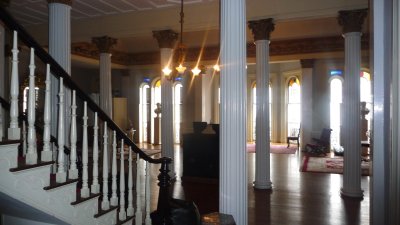
View from the Front Hallway of Belmont looking into the Grand Salon (where parties were held). |
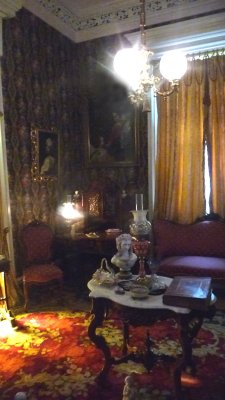
The Ladies Parlor or "Tête-à-Tête Salon." It is a dark room. They kept the curtains drawn probably due to the hot climate. |
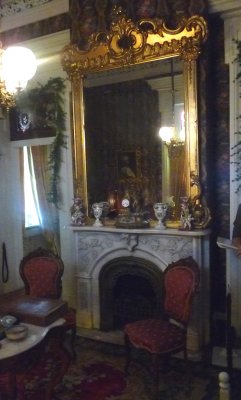
Mantel inside the Ladies Parlor with decorative porcelain pieces and a clock. |

The furniture in this room is not original, although the room is decorated with period pieces of that time. |

The bible on the table is one of the few original things in this room. |

This bowl on the table with the fish inside is an original piece collected by Adelicia and made out of alabaster. |

Although it uncertain what the wallpaper looked like, this one was chosen because it was popular during the time period. |
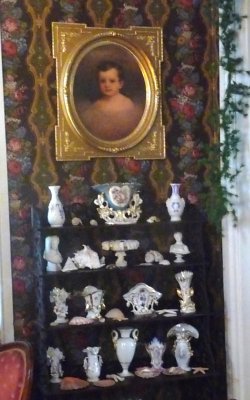
Bric-a-brac that Adelicia collected are period pieces. A copy of a baby portrait of Claude, one of her sons who survived her. |
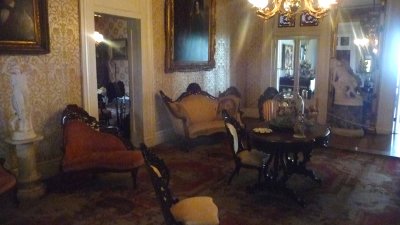
The Central Parlor in Belmont Mansion. |

Adelicia's portrait with her horse "Bucephala" (named after Alexander the Great's horse) was painted before she was married. |

Ornate Central Parlor with a crystal chandelier, a piano and marble fireplace. The furniture is in this room is original. |

This is portrait of her 3 girls (the baby is Emma, and Adelicia and Victoria) from her marriage with Isaac Franklin. |

Sculpture called "Sans Souci" by Courtney Ives (American) acquired by Adelicia on her "grand tour" of Europe from 1865-1866. |
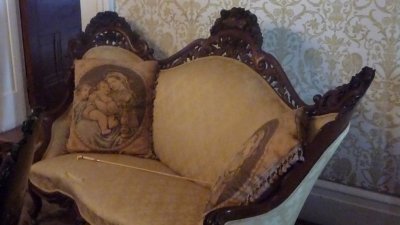
This is an original couch made by John Henry Belter's New York company. He perfected this curved technique of the wood. |
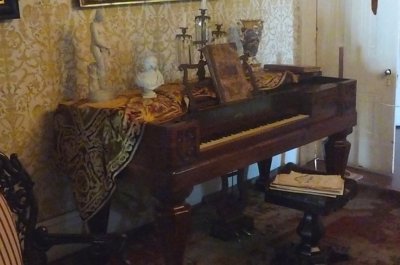
This piano is also original and belonged to Adelicia. |

This room is called the "Winter Parlor" since a lot of light comes into this room. |

The furniture in this room is original and was also made by John Henry Belter's New York company. |

You can see the many windows in this room from which a lot of light comes in. |
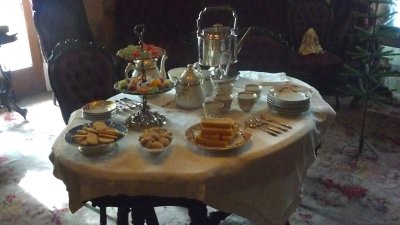
Tea and pastries set up in the Winter Parlor for afternoon teas (as it probably was when Adelicia lived here). |
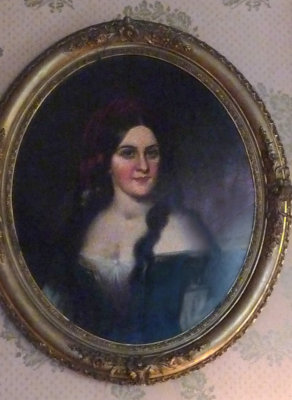
Portrait in the Winter Parlor of Adelicia's niece, Corinne Goodman who lived in Memphis. |
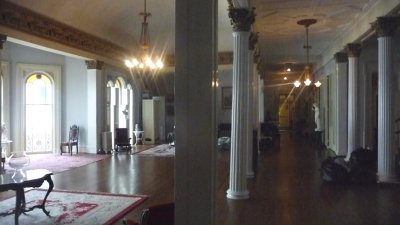
The Grand Salon is part of what Adelicia and Joseph added on in 1859. Previously, this was the back porch. |
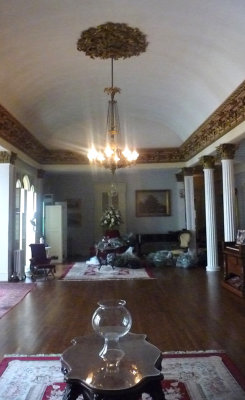
The original architect, Adolphus Heiman, who built the house, added this barrel-vaulted ceiling room for entertaining. |
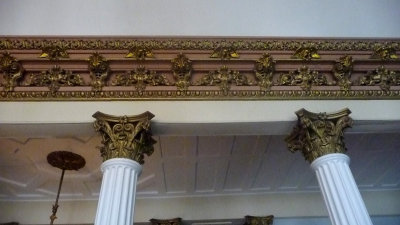
The plaster molding and the light fixtures are original. |
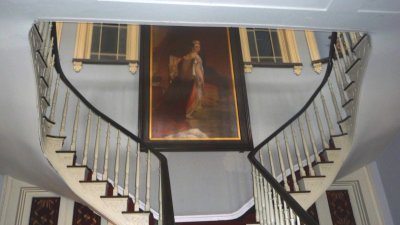
A portrait of a young Queen Victoria hangs over the grand staircase off of the Grand Salon. |
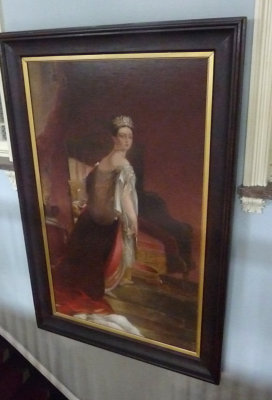
Close-of Queen Victoria's youthful portrait painted on wood. Joseph bought it in New Orleans in 1855 for about $5,000. |

This fountain, which is now in the back courtyard, used to be inside the house. |
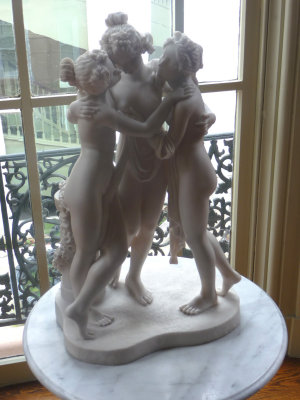
More statuary in the Grand Salon, probably acquired by Adelicia during her grand tour of Europe from 1865-1866. |
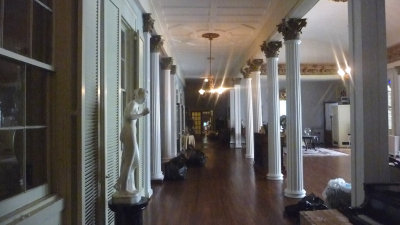
View looking in the other direction of the Grand Salon. Note the wood floors, columns and statuary. |
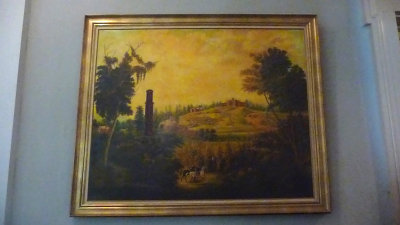
Painting of what Belmont Mansion looked like in Adelicia's time. They had gas lamps, so it was like a shining beacon on a hill. |

The open-back chairs and mirror in the Formal Dining Room are original and belonged to Adelicia. |
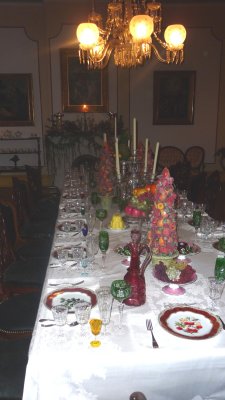
Elaborate dinner parties with 18 or 20 courses were held in the Formal Dining Room. |
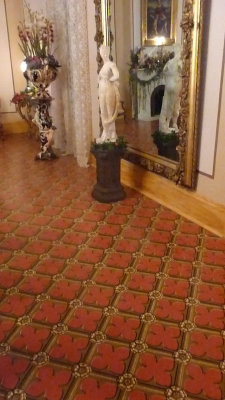
The flooring in the Formal Dining Room resembles the linoleum that we use today. The wood in this room was oak "faux-painted." |
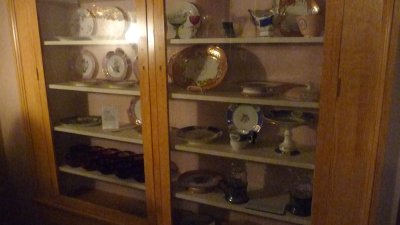
Examples of some of the different sets of china that Adelicia owned are on dislplay in this case. |
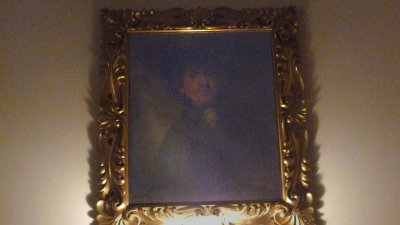
Painting in the Formal Dining Room is a copy of a youthful self-portrait by Rembrandt. Much of Adelicia's art were copies. |

Across the hall is the smaller Family Dining Room where they spent more time. It was also used as a den. |

This is set up like a luncheon with the original every-day china. |

An portrait of an older Adelicia in the Family Dining Room. |
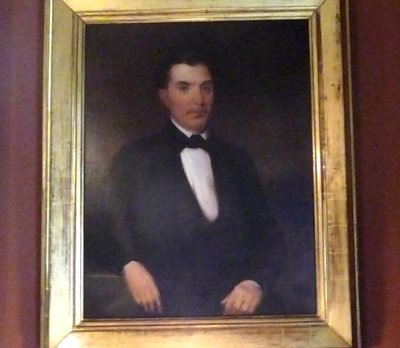
Another portrait in the Family Dining Room of the first husband (who had the money), Isaac Franklin. He looked like Clark Gable! |
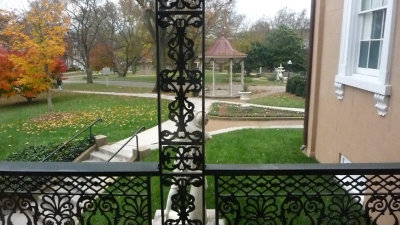
Window from the front with a balcony where you can see the grounds and the gazebo in front of Belmont Mansion. |

Joseph's Library (the second husband) with a desk and fireplace. |
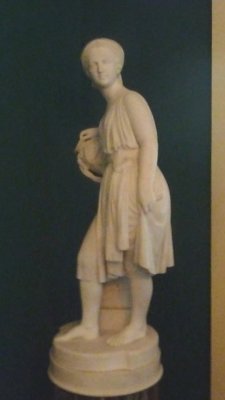
Statue in Joseph's Library called "Rebecca at the Well," which Adelicia picked up in Europe between 1865-1866. |
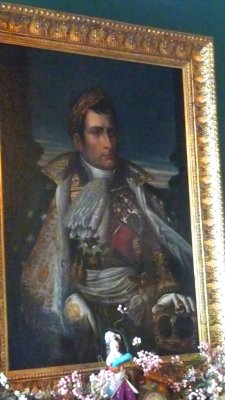
Also, in Joseph's Library is a copy of a painting of Napolean III being crowned king of Italy. It was one of Joseph's favorites. |
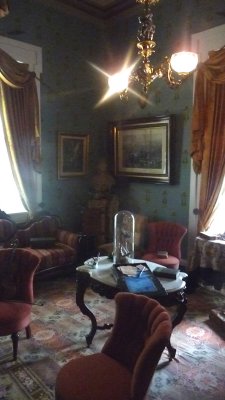
This room was probably a Gentlemens' Parlor where men came and smoked cigars and drank port after dinner. |

The decor of the room is rather masculine with an elks head on the wall. |

Adelicia's oldest son, Joseph, was the first game warden in Tennessee, and the 3rd son, Claude, became one in Maryland. |
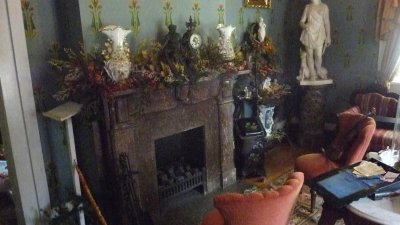
The fireplace (in which they burnt coal) with a marble sculpture of Pocahontas in the corner of the room. |

Close-up of Pocahontas. This statue was also acquired by Adelicia on her grand tour of Europe between 1865-1866. |

View of the fireplace made of local Tennessee Chaplain marble. Every mantelpiece at Belmont Mansion has a clock on it. |

View from the second floor of steep stairs going to the cupalo (for air flow). The second floor was once a porch. |
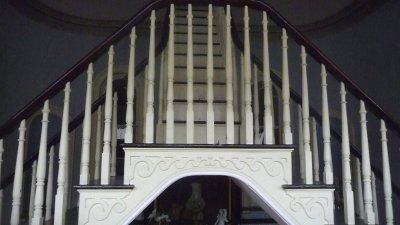
When the barrel-vaulted Grand Salon was added in 1859, they walled up the 2nd floor porch and added windows. |

Painting of the cupalo to allow the house to breathe. A lot of paintings, like Napolean III, were hung in the 2nd floor porch. |
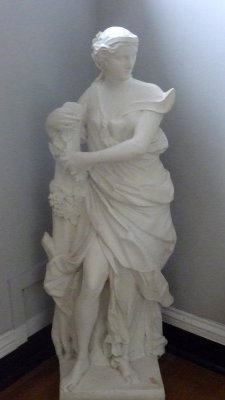
A copy of a sculpture that didn't belong to Belmont Mansion and was sent to them by mistake. They put it on the 2nd floor porch. |

One of 5 bedrooms on the 2nd floor. Only the armoire is original to this room. |
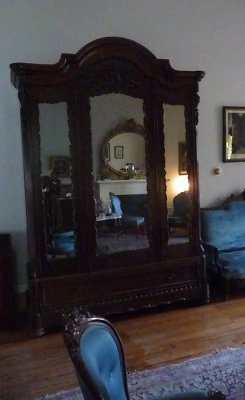
Close-up of the original mahagony armoire in this bedroom. |

This four poster bed is a mahagony period piece from the 1850's and was a gift to Belmont Mansion. |
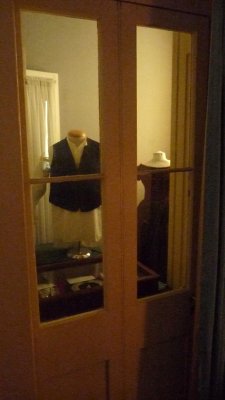
Off of this bedroom is the Trunk Room, where ladies' clothes were stored in trunks. Mens' clothes were stored in armoires. |
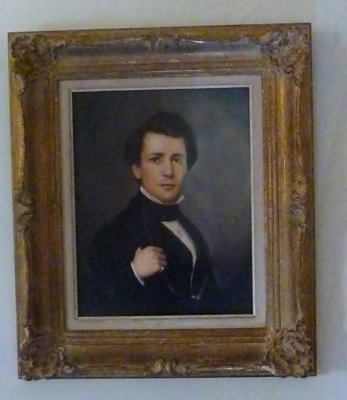
When Joseph and Adelicia got married, these miniature portraits were painted of them. |
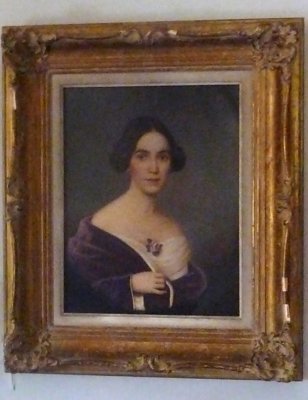
Miniature marriage portrait of Adelicia. |
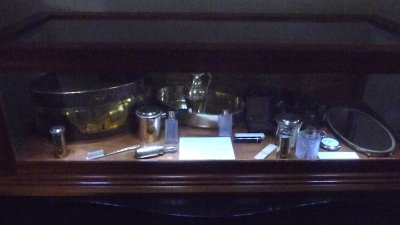
In this case is the wedding present that Adelicia gave to Joseph, which is a French travel kit or "nécessaires de voyage." |

Joseph was an admirer of Napolean Bonaparte. The kit was made by the same gold and silversmiths who made Napolean's travel kit. |
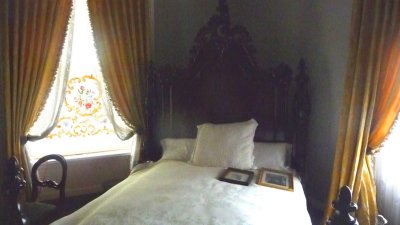
They do not know who had what room, but they know that the bed, dresser and armoire in this middle bedroom are original pieces. |
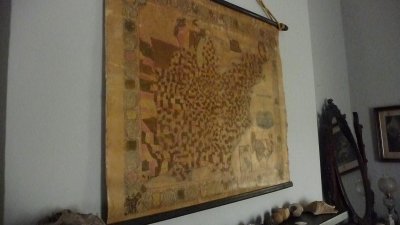
The map is also an original piece found in the house from the 1840's showing the United States at that time (and by county). |

The pine floors in this room are also original, as is the furniture. |

The style was to have wall-to-wall carpet strips laid down, so you would not have seen the floors in Adelicia's time. |
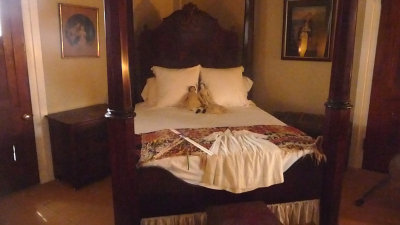
Adelicia referred to this room as the Nursery. |
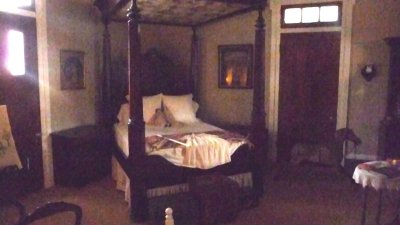
The bed is original, and the furniture is identical to the furniture that was in the room. |
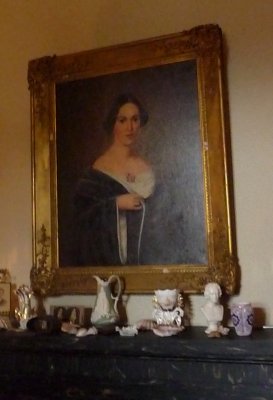
A large copy of a "miniature" of Adelicia. Miniatures were painted of Adelicia and Joseph the year they got married. |

Pictures on the wall in the Nursery. The lower one is a portrait of Adlelicia's personal maid, Eva Snowden Baker. |

Before the war, they had about 25 slaves at Belmont and about 1,000 at the plantation in Louisiana. |

Also, on the second floor is Adelicia's bedroom, which was under renovation. They have their work cut out for them! |

They know it was her bedroom, because it had the most elaborate wallpaper. The paper also hangs in the Hermitage. |
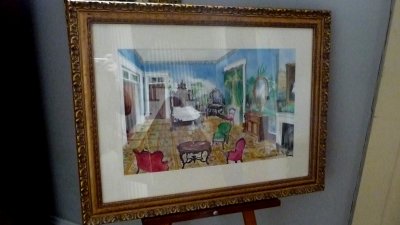
This is an artist's rendering of what they think that Adelicia's bedroom looked like. |

The tour guide, Ellen, held up samples of the wallpaper in Adelicia's bedroom, which was extremely elaborate. |

View inside a pantry of some of Adelicia's china. |
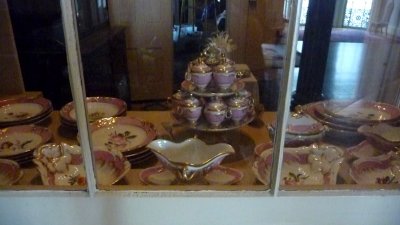
Close-up of the china. This is the oldest china, because it was passed down to Adelicia from her mother. |

This pantry, where food was stored, worked in conjunction with the kitchen, which was down in the basement. |

It was easier to wash the dishes on the ground floor rather than having to carry them down to the basement. |
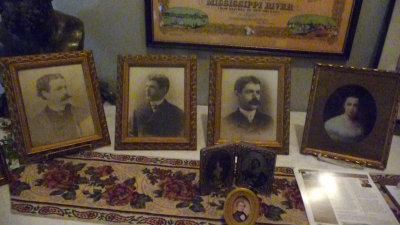
From left to right are Adelicia's grown children. The oldest was Joseph, then William, Claude and Pauline. |
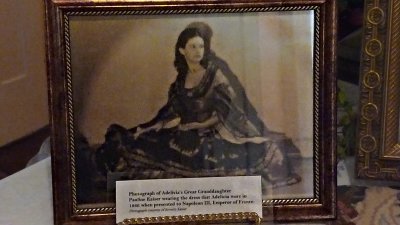
Adelicia's great-granddaughter, Pauline Kaiser, wearing the dress that Adelicia wore in 1866 at the court of Napolean III. |
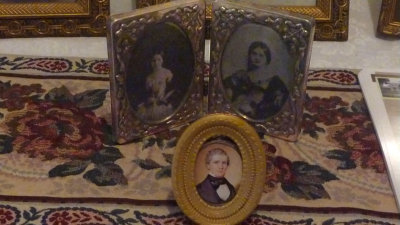
Daguerreotypes of Corrine and Laura, Adelicia's sisters and a miniature of Dr. Cheetham, the last (younger) husband. |
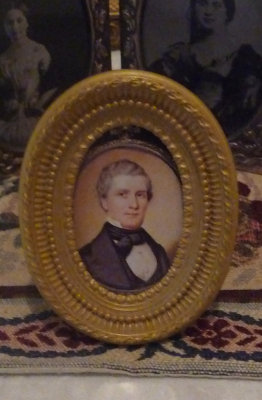
Close-up of the miniature of Dr. Cheetham. Many eyebrows must have been raised when Adelicia married a younger man! |

Daguerreotype of Adelicia and her daughter Pauline. |

Photograph of the plantation house in Louisiana. Plans to make the house more elaborate were curtailed when the war broke out. |

The big white area on the Mississippi/Louisiana border is Adelicia's 8,600 acre plantation. It is now Angola State Penitentiary. |
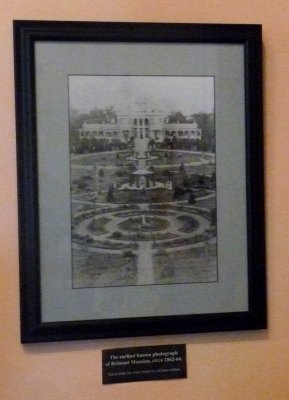
A daguerreotype of Belmont that was taken from the water tower by a Union soldier. It shows how big and elaborate it really was. |

The friendly director of Belmont Mansion who was in the process of putting up Christmas decorations. |
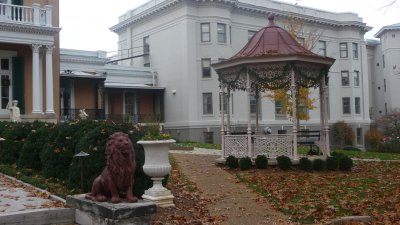
The many gazebos around the property (which is now Belmont University) are from Adelicia's time. |

This fountain in front of the house is original to Adelicia's time. Most of the statues are replicas of the originals. |

The grounds also included lavish gardens, conservatories, an aviary, a lake and a zoo. |
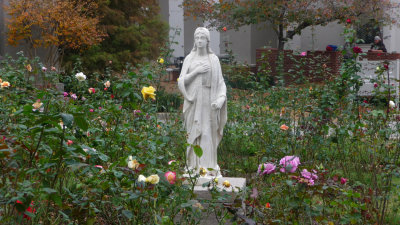
Close-up of the rose garden and more statuary. |

Months before her death, Adelicia sold Belmont, and much of the land, today, is owned and occupied by Belmont College. |
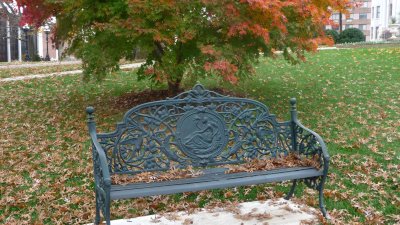
An ornate bench underneath a tree changing colors in November. |
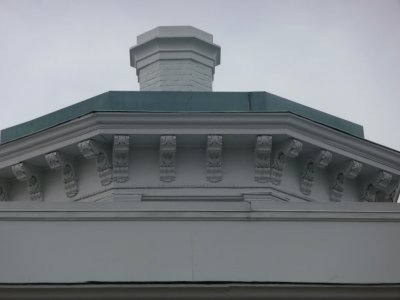
From below, you can just make out the cupalo (a domelike structure surmounting a roof, used as a lookout or to admit air). |
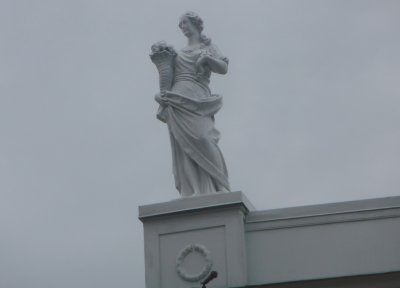
Ancient-looking statuary also adorns the top of Belmont Mansion such as this statue on the left. |

On the right of the top of Belmont Mansion is another classical sculpture. |











